Learn About Stupas

Symbols of Enlightenment
Stupas are sacred monuments that embody the enlightened mind.
The word “Stupa” is a Sanskrit word that literally means “to heap” or “to pile up.” The Monnier Williams Sanskrit-English Dictionary says the stupa is “…a Buddhist monument, (generally of a pyramidal or dome-like form created over sacred relics of the historical Buddha (563-478 BC) or on spots consecrated as the scenes of his acts); a relics shrine or relics casket.” It goes on to say that ‘stupa’ was originally a topknot of hair, designating the upper part of the head, but subsequently became used as an architectural term, indicating a monument of a dome-shaped form over the sacred relics of the Buddha or other saints or venerable persons. The connection between Shakyamuni and a topknot is apparent since he is often depicted as having such a topknot symbolizing his attainment of Enlightenment.
Stupas were found in India before the birth of Buddha Shakyamuni where mounds of dirt were built around a tree as a tomb for the remains of important figures such as kings and heroes. It’s said that the Buddha was the one who changed that practice when he asked that his own remains be placed within stupas that would represent the Awakened Nature, as a reminder of the potential for enlightenment within us all.
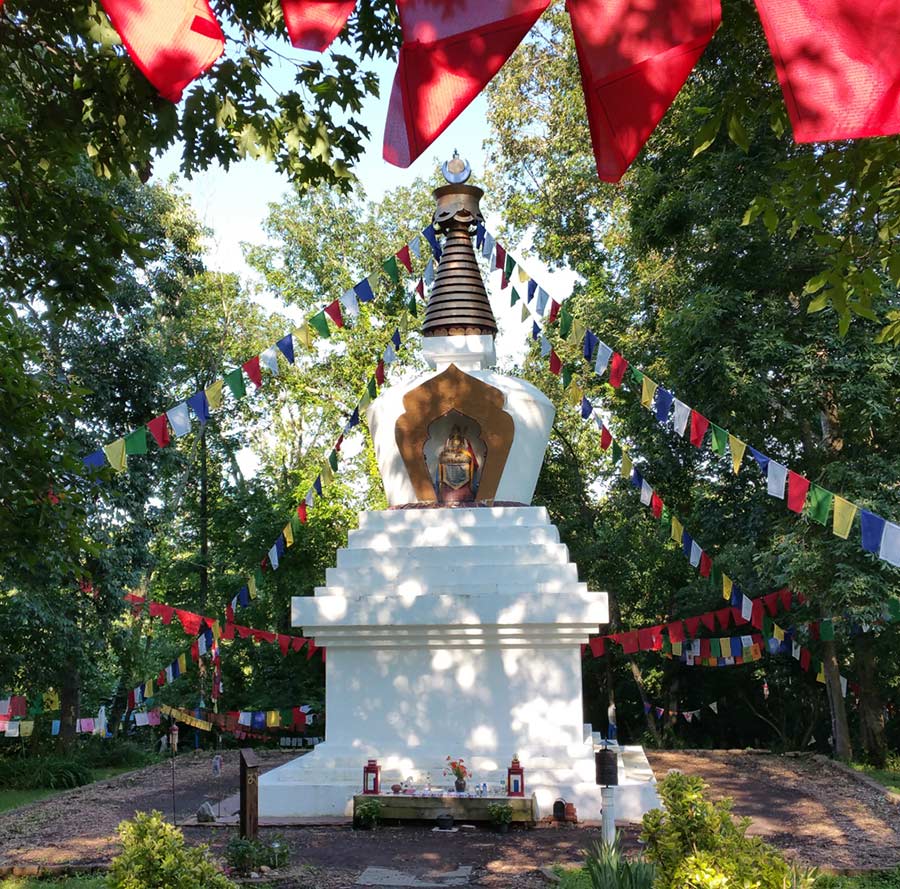
The Enlightenment Stupa at KPC Maryland was our first Stupa built in 1988.
The Power of Stupas

Because every element of a Buddha’s physical body is pervaded with the pure energy of Enlightened Mind, the teacher’s remains after cremation are considered sacred. One sign that a teacher is an enlightened manifestation is that relics will be found in the ashes that resemble small, round pearls which can be white, red, or brown. These are often the relics that are put inside stupas being built today.
Stupas are an ancient form of sacred architecture that represent the heart of enlightenment – not just as a form of tribute but as a radiating presence that transmits blessings to all those who come in contact with them. If properly constructed and empowered, a stupa is like a spiritual generator. It broadcasts virtue of such power that it brings peace and harmony to all beings and balances the forces of nature.
A Stupa naturally establishes peace and harmony while subduing negative forces, like war and famine. It helps to prevent disease and brings blessings of health, prosperity and well-being to the community. No matter the shape or style, a properly constructed and consecrated stupa provides the world a place of blessing and spiritual refuge.
Shakyamuni Buddha ignited an appreciation for the spiritual potency of stupas. The Buddha taught and demonstrated that stupas are powerful agents of purification and spiritual transformation. On one occasion he sent a dying man to restore and re-consecrate a stupa in disrepair. After the Brahmin completed the work according to the Buddha’s instructions, his body became miraculously strong and majestic.
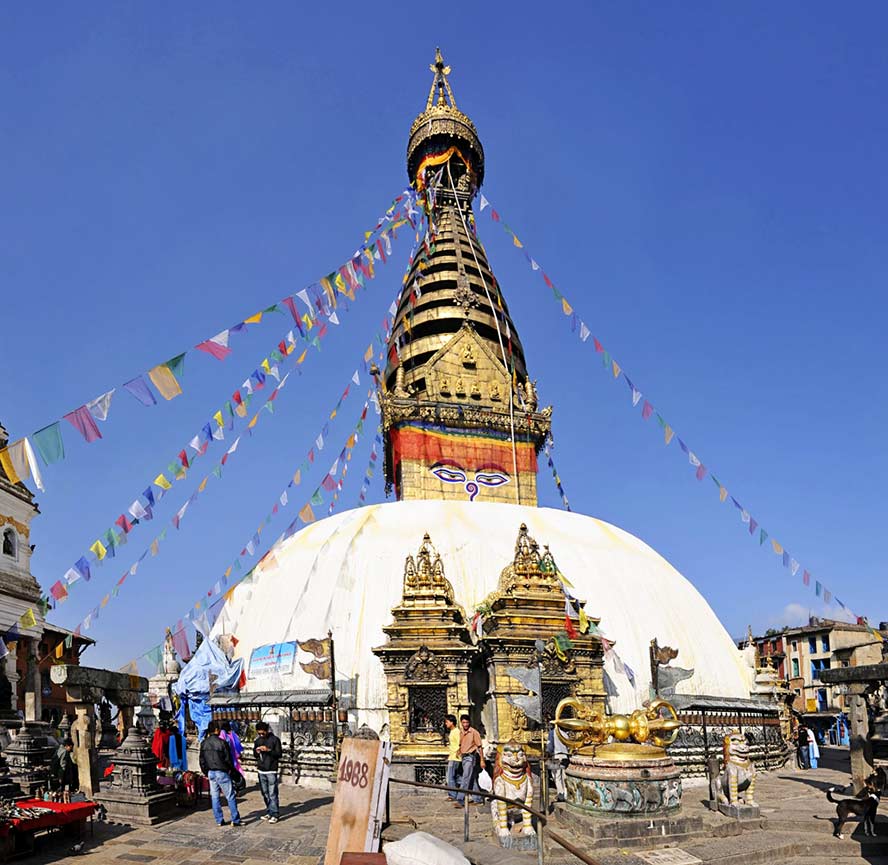
Swayambhunath Stupa lies in the northwest of Kathmandu Valley. Swayambhu literally means “self-existent one” and is believed to date back to 460 A.D.
Symbolism of a Stupa

Stupas speak of enlightenment on many different levels. The outer form of a stupa represents a meditating Buddha, seated and crowned. When seen from above, a stupa is a perfect mandala, a pure distillation of the universe.
But that is only the beginning of a stupa’s meaning. Every architectural feature of the stupa symbolically represents a facet of the spiritual path. For example, a stupa incorporates five basic geometric shapes that correspond to the five elements. Each element, in turn, corresponds to an essential attribute of a fully awakened being. The square base of the stupa represents earth and equanimity; the round dome, water and indestructibility; the triangular spire, fire and compassion; the semi-circular umbrella, wind and all-accomplishing action; and at the very top, the jewel-shaped tigle or drop represents space and all-pervading awareness.
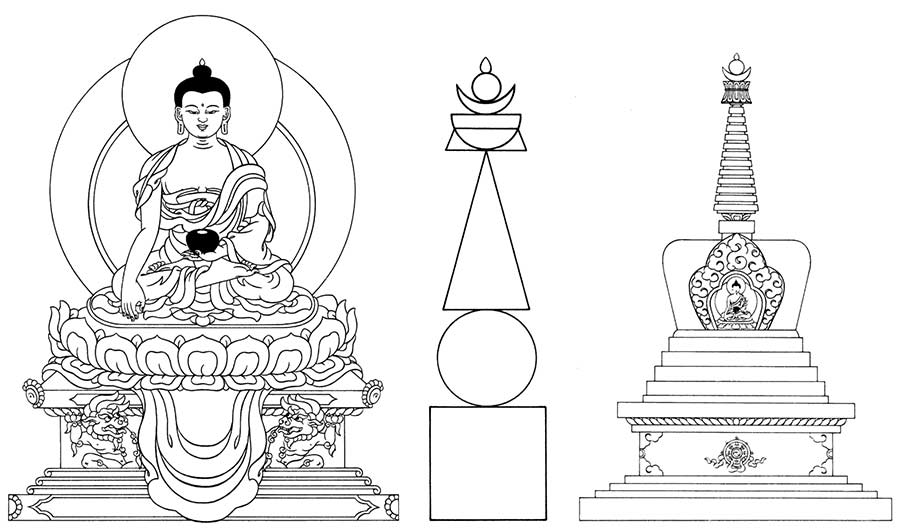
On a more general note, the configuration of the entire universe as conceived in traditional Buddhist cosmology is a gigantic stupa—as is the structure of a person’s subtle body. Thus the inner level of experience relates directly to the physical cosmos, and a stupa is a gateway for merging the innate wisdom nature with the Dharmadatu or “field of dharma” that has no beginning and no end.
As Buddhism moved from culture to culture, the outer appearance of the stupa changed not only in size and materials, but also in its shape. In each country, different facets of the stupa’s form were emphasized. In Tibet, the stupa (chorten) was placed on a lion throne and elaborately detailed. In Nepal, the dome was emphasized, and eyes were painted on the harmika (throne of the spire). In Korean, Chinese, and Japanese pagodas, the spire became the focal point. When looking at these structures superficially, it may seem that they represent separate architectural traditions. In fact, they do not. Adrian Snodgrass in The Symbolism of the Stupa points out that what makes a stupa a stupa is its internal symmetry and orientation in space. These and other specific instructions come directly from the Buddha and have been codified in the Drimed Namnyiy or the “Two Stainless Cycles.”
The Five Elements and Five Colors

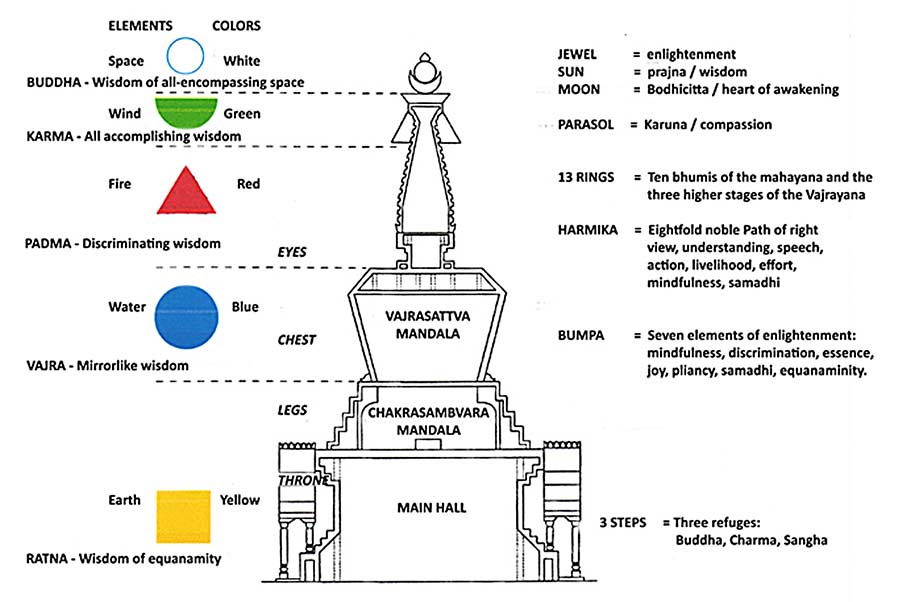
The stupa also symbolizes the five elements and colors and their relationship to Enlightened Mind:
Base – Square – Yellow – Earth – Equanimity
Dome – Circle – White – Water – Indestructibility
Spire – Triangle – Red – Fire – Compassion
Parasol – Half Circle – Green – Wind – All-accomplishing Action
Jewel – Dewdrop (no shape/no color/void) – Space – All-pervading Awareness
Sections of the Stupa symbolize the Path to Enlightenment

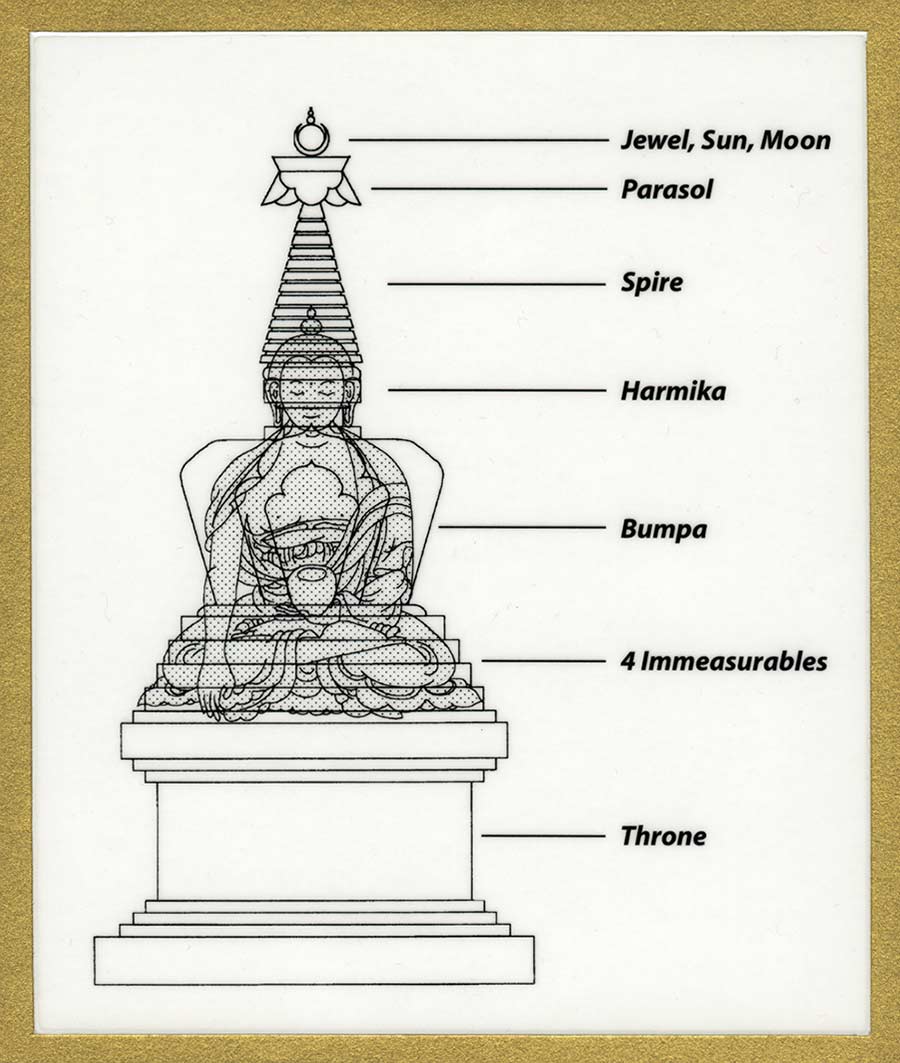
From the bottom up:
The three steps at the base, the Throne: the three refuges of Buddha, Dharma, and Sangha
The four steps below the Bumpa, or dome: the legs of the Buddha: the Four Immeasurables of loving kindness, compassion, joy and equanimity
The Bumpa: the Buddha’s chest: the Seven Elements of Enlightenment: mindfulness, discrimination, exertion, joy, pliancy, samadhi, and equanimity
The Harmika, just below the spire: Eyes of the Buddha: the Eight-fold Noble Path of Right View, Right Intention, Right Speech, Right Action, Right Livelihood, Right Effort, Right Mindfulness, Right Concentration
The Spire, or 13 rings: the ten levels or bhumis of the Mahayana path and the three highest stages of the Vajrayana path.
The Parasol: compassion
The Moon/Sun shapes represent the union of compassion and wisdom, joining the all-accomplishing action of compassion with the all-pervading awareness of wisdom
Jewel/Sun/Moon: Enlightenment, Wisdom, Bodhicitta (Heart of Awakening)
Eight Great Deeds

Since Shakyamuni Buddha’s passing, the stupas that have been built are representations of his form and memorials of his Eight Great Deeds. The structures are constructed according to guidelines found in Buddhist scripture that he left for us. Many stupas today are built on these representations.
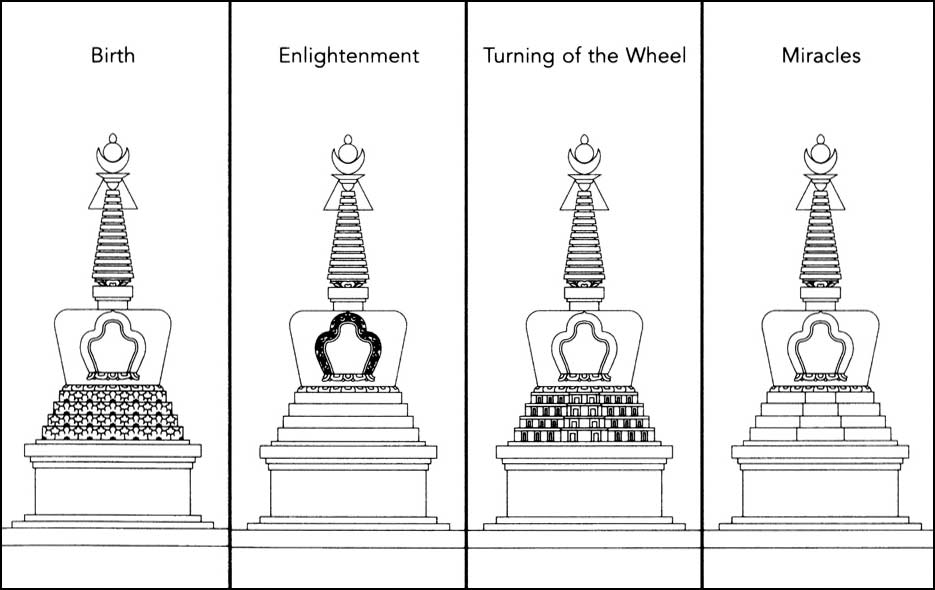
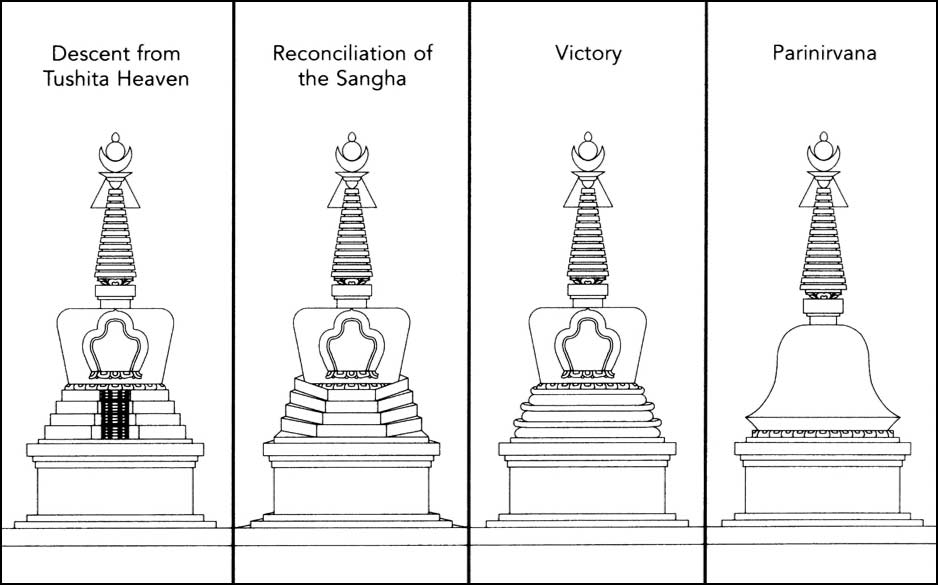
After the Buddha took his last breath, and his body cremated, his ashes were divided into eight parts. Eventually, in order to share the blessings with the community, the kings and princes who were the caretakers of the relics built stupas to house them. Of the ancient stupas still intact today, most are said to contain relics of Shakyamuni Buddha.
“This stupa is called a Dharmakaya Stupa. Within it, the guru dwells unchanging. The Buddha said whoever sees a Dharmakaya Stupa will be liberated by the sight of it. Feeling the breeze nearby the stupa liberates one by its touch. The sound of the tinkling bells hanging on the stupa liberates by their sound. Thus, having seen or experienced this stupa, by thinking of one’s experience of it, one is liberated through recollection.”
– His Holiness Dilgo Khyentse Rinpoche
What’s inside a Stupa?

Stupas are filled with tsa-tsas, small clay miniature stupas, ceremonial objects and precious relics from enlightened masters. Thousands of large and small rolls of sacred mantra are printed, covered with fine cloth and ribbons. Everything that goes into a stupa is blessed in elaborate ceremonies and placed in every chamber of a stupa all the way to the top of the spire. Stupas contain wealth vases to heal and protect the environment to replenish the five elements (earth, water, fire, air and space), to restore the earth’s vital energies, and to foster temporal and spiritual prosperity. The vases symbolize the inexhaustible treasury of the Buddha’s teachings – wisdom that never diminishes.
(Click the diagonal arrow icon below the flipbook viewing pane to enjoy a larger size of this beautiful book.)
In addition to sacred and ritual substances, other offerings include everyday objects. For example, buckets of grains, rakes and shovels offered to antidote hunger and famine, and homeopathic remedies and other medicines to promote health and healing. Water, rocks, and earth from every continent and sometimes meteorites from space to extend the Stupa’s blessing throughout the earth and sky.
One of the most remarkable and important features inside the Stupa is the sok-shing, a tapered, four-sided cedar column that is the central channel and life force of the Stupa. The sok-shing in the Amitabha Stupa in Sedona is carved at the top like a stupa and a thunderbolt or dorje, at the bottom.
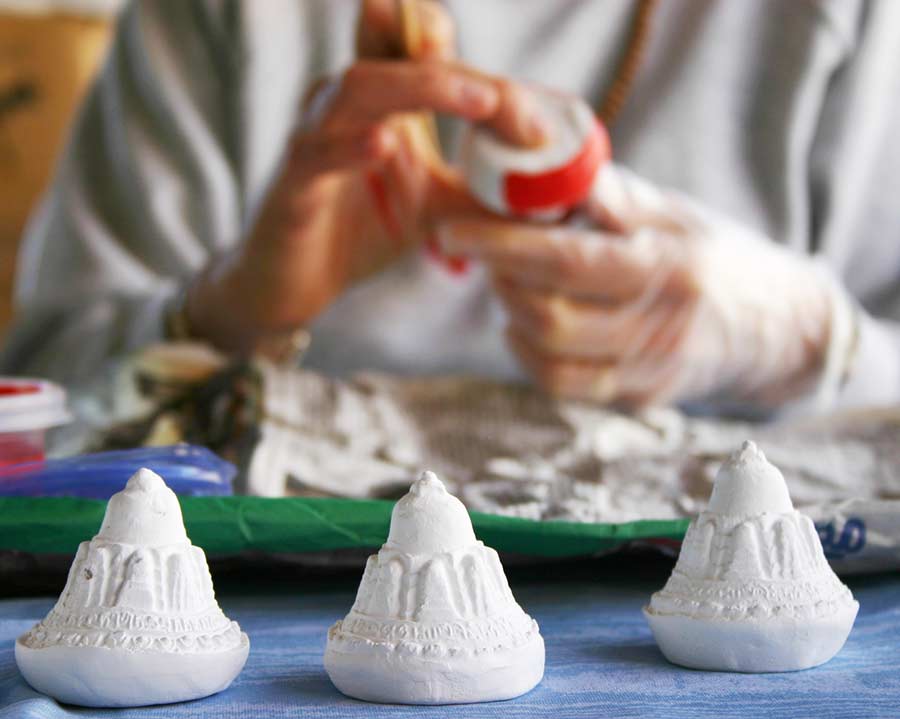
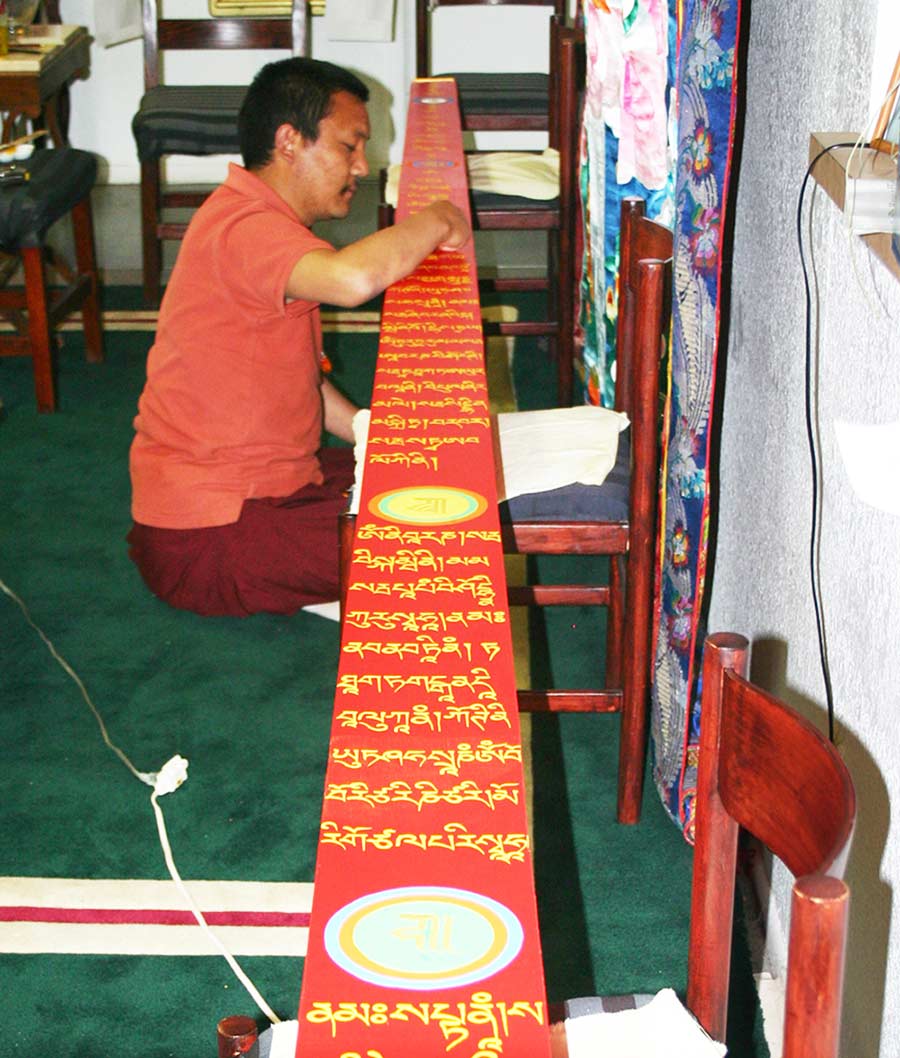
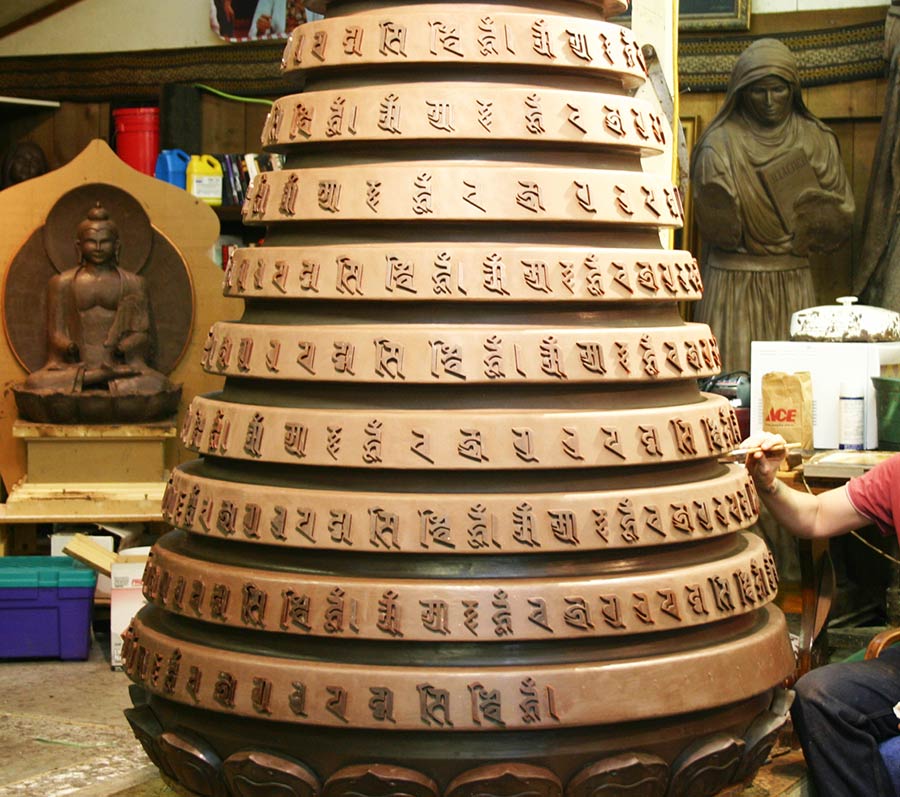
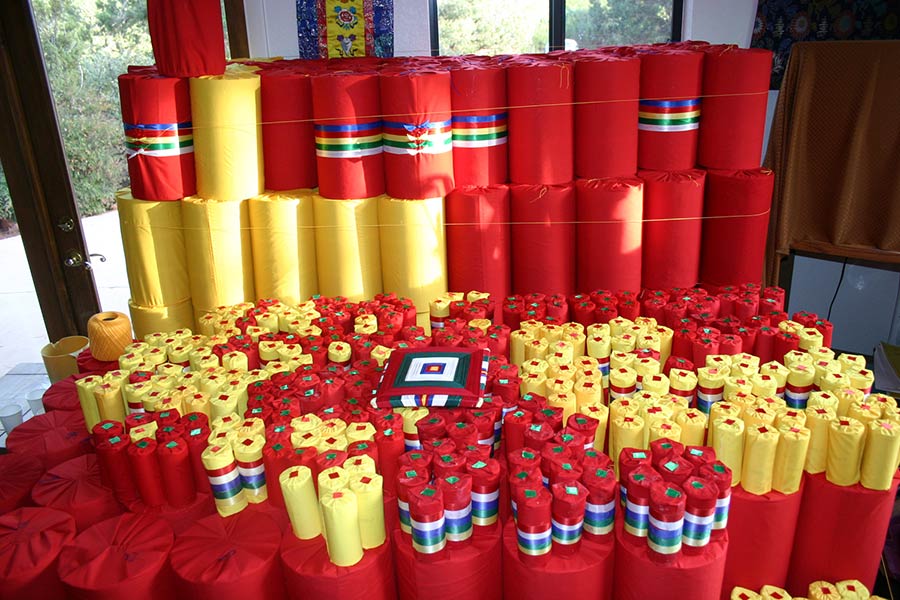
Recommended Reading

Dowman, Keith, trans. Legend of the Great Stupa. Berkeley, California: Dharma Publishing, 1973.
Govinda, Lama Anagarika, Psycho-Cosmic Symbolism of the Buddhist Stupa. Dharma Press, 1976.
Landaw, Jonathan and Andy Weber, Images of Enlightenment (Tibetan Art in Practice). Ithaca, New York: Snow Lion Publications, 1993.
Snodgrass, Adrian, The Symbolism of the Stupa. New York: Cornell University, 1985.
“The Stupa: Sacred Symbol of Enlightenment,” Crystal Mirror Series 12, (1997), Dharma Publishing, Berkeley, California.
Tulku Sang-ngag Rinpoche, “Stupas: Incalculable Sources of Blessing,” Mirror of Freedom 13 (1995). Chagdud Gonpa/Padma Publishing.



